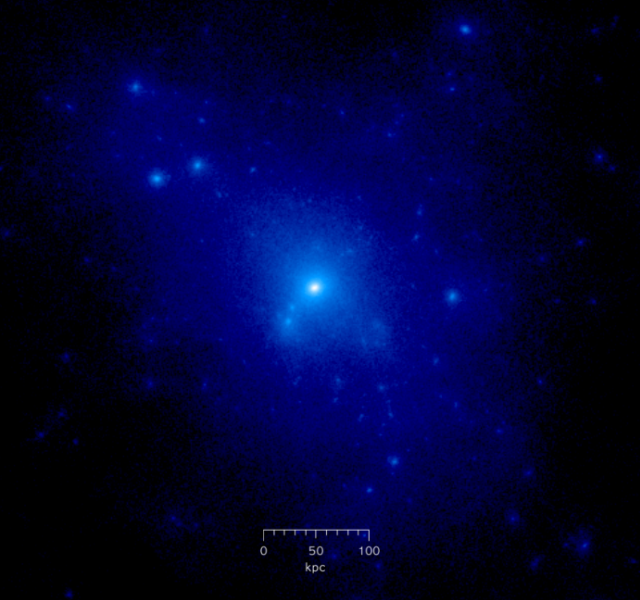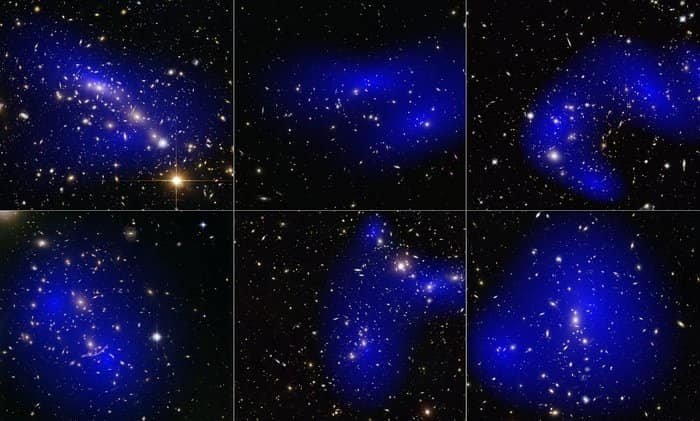Dark Matter and Dark Energy
Astronomical data and the latest observations in cosmology show that 95% of the energy density of the universe is in the dark sector consisting of dark matter, unidentified forms of matter, and dark energy of unknown origin. Dark matter and dark energy are not the same.
Dark matter is responsible for flattening the rotation curve of galaxies. It also acts as a precursor to the great structures of the universe. Dark energy is responsible for accelerating the expansion of the universe. Understanding the mechanisms underlying this acceleration is one of the great challenges of modern physics. This problem is related to the cosmological constant, a puzzle that dates back to the early days of general relativity.
The galaxy of our universe seems to have accomplished a real feat. They spin so fast that the gravity produced by the observable matter they contain cannot hold them together; logically, they should have been canceled long ago. The same is true for clusters of galaxies. That’s why scientists believe that something invisible is involved: something we haven’t been able to detect directly gives these galaxies the extra mass, which generates the extra gravity they need to keep from collapsing. This mysterious presence is called “dark matter”.
Dark matter
Unlike ordinary matter, dark matter is not sensitive to electromagnetic forces. Because of this, it cannot absorb, reflect, or emit light, making it very difficult to detect. Scientists can only deduce the existence of dark matter from the gravitational effects it appears to have on visible matter. Dark matter appears to be about six times the mass of visible matter; it should make up about 27% of the Universe. This is serious: the matter that we know of and that makes up all stars and galaxies represents only 5% of the Universe.
The nature of dark matter
But what is the nature of dark matter? According to one theory, it could contain so-called “supersymmetric” particles, hypothetical particles that would be associated with particles already known from the Standard Model. Experiments at the Large Hadron Collider (LHC) may provide more evidence about dark matter.
Some theories predict that dark matter particles will be bright enough to be produced at the LHC. In this case, they will pass through the detector undetected. They will, however, bring energy and encouragement. Therefore, it is possible to infer their existence from the energy and momentum lost after the collision. Dark matter candidates are often present in theoretical physics outside the Standard Model, such as supersymmetry and extra dimensions. One of these theories evokes the existence of “hidden valleys,” parallel worlds made of dark matter that has very little in common with matter we know about.
If any of these theories were confirmed, it would allow scientists to better understand the composition of the Universe, and, in particular, how galaxies don’t decompose.
Dark energy
Dark energy makes up about 68% of the Universe and appears to be associated with a vacuum. It is evenly distributed in the Universe, not only in space but also in time – in other words, its effect does not diminish with the expansion of the Universe. This even distribution means that dark energy does not have a local gravitational effect, but rather a global effect throughout the Universe. This produces a repulsive force that tends to accelerate the expansion of the Universe.
The rate of expansion and acceleration can be measured by observing and applying Hubble’s law. These measurements, along with other scientific data, have confirmed the existence of dark energy and provide an estimate of the amount represented by this mysterious substance.
What do dark matter and dark energy have in common?
What about the dark energy over there? Is it the same thing? From the gravitational attraction exerted by dark matter? Not all. The only common point between dark matter and dark energy is that the terms “dark” have similar meanings. Something that is invisible in the darkness of space through our telescopes, and which imparts a force whose effects we can see without finding its source and knowing its true nature. If dark matter has been used to explain the fact that galaxies stay close to each other, dark energy is called in to explain the fact that the universe is expanding.
Indeed, since the observations of the American astrophysicist Edwin Hubble, in the 1930s, we have known that stars and galaxies are gradually moving away from each other, a sign that our Universe is expanding like a balloon about to swell. However, if we assume that the main force acting on massive bodies (planets, stars, black holes, etc.) is gravity, the expansion of this Universe will gradually slow down under its influence. Indeed, gravity is an attractive force that has the effect of bringing masses closer to each other and not moving them apart.
However… towards the end of the 1990s, astrophysicists did notice that the expansion of the Universe was not happening at a constant rate… but rather accelerating! An invention that won the Nobel Prize in 2011 (S. Perlmutter, B. Schmidt and A. Riess). Here again, astrophysicists, unable to explain this state of affairs, have imagined the presence of “dark energy” that offsets the effects of gravitational attraction, or even reverses it. An energy “that we don’t know much about today”…
Finally, dark matter and dark energy seem to perfectly explain the dark spots in the structure and history of our Universe. It is for this reason that they were both “created”. Both are also mere speculations, have never been observed directly and are highly controversial. This is their biggest common point.

Simulated dark matter halo from a cosmological N-body simulation. http://en.wikipedia.org/wiki/User:Cosmo0, Public domain, via Wikimedia Commons
Dark matter significantly distorts our galaxy
A mysterious dark matter halo could be the reason our galaxy, the Milky Way, isn’t as flat as it should be. A recent study suggests that this invisible dark matter has distorted the Milky Way, giving it the appearance of a crushed sombrero.
Until recently, scientists believed that the Milky Way was a flat disk dominated by two spiral arms. However, measurements taken since the mid-20th century show that the galaxy is inexplicably distorted. This deformation occurs mainly at the borders of our galaxy. Some regions tilt in one direction while others tilt in the opposite direction, giving it a distorted appearance.
Dark matter makes up 85% of the matter in the Universe, but because it does not interact directly with light, it is completely invisible. Nevertheless, its gravitational effects on its environment are observable. One way dark matter manifests itself is by accelerating stars to otherwise inexplicable speeds as they orbit galactic centers.
The galactic halo appears just beyond the spiral arms of the Milky Way. In a 2022 study, astronomers used the European Space Agency’s Gaia Observatory to map the positions and movements of about 2 billion stars in the Milky Way. They discovered that the stars in the galactic halo were strangely unbalanced.
To understand what this could mean for the dark matter halo, the researchers used a computer model to recreate a young galaxy similar to the Milky Way. After simulating the galaxy for 5 billion years, they found that they had created a galaxy very similar to ours.
To do this, it was necessary to introduce an inclination of the dark matter halo into the simulation. The cause of this tilt is not certain, however the researchers’ simulations suggest that it is likely that a gigantic collision, perhaps with another galaxy, could have caused this tilt.
Sources: PinterPandai, NASA, ESA
Photo credit: European Space Agency (ESA) Hubble
Nearest Galaxy and the distance from Milky Way (our galaxy)?



